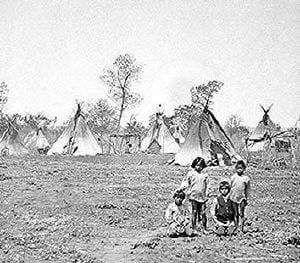Wichita (tribe)
- For other uses, see Wichita (tribe) (disambiguation).
The Wichita are a tribe of Native Americans, indigenous inhabitants of North America, who speak Wichita, a Caddoan language. The tribe was most populous in the Southwestern United States.
The Wichita formed a gang loose confederation on the Southern Plains, including such tribes as Panis Piques, Taovayas, Guichitas, Tawakonis, Kichais, and Wacos, and they lived in fixed villages notable for domed-shaped and grass-covered dwellings. The Wichita were successful hunters and farmers, skillful traders and negotiators. They ranged as far south as San Antonio, Texas to as far north as Great Bend, Kansas. A semi-sedentary people, they occupied northern Texas in the early 1700s and were involved in trade with other Southern Plains Indians on both sides of the Red River and as far south as Waco. The Wichita lived in huts made of forked cedar poles cover by dry grasses, but would abandon them in the winter to go hunt American Bison.
The Wichita were known to tattoo their faces and bodies with solid and dotted lines and circles. They called themselves "raccoon-eyed people" (Wichita Kitikiti'sh) because of the tattooed marks around their eyes. They wore clothes made of tanned hides, the women often decorating their dresses in elk teeth.
First Contact
The Wichita's population at the time of first contact with the Europeans was estimated to be 200,000. Spanish explorer Francisco Vásquez de Coronado encountered several villages in the area now known as Kansas. Coronado said:
"There are not more than twenty-eat meat raw like the Querechos [the Apache] and Teyas. They are enemies of one another...These people of Quivira [later known as the Wichita] have the advantage over the others in their houses and in growing of maize".[citation needed]
By 1719 the Wichita had largely migrated southward to Oklahoma. During the Civil War they moved back to Kansas and established a village at the site of present-day Wichita, Kansas. Their numbers dwindled rapidly upon contact with people of European descent. In 1790, it was estimated that there were about 3,200 total Wichita. By 1868, the population is recorded as being 572 total Wichita. By the time of the census of 1937, there were only 100 Wichita officially left.
Origins
Numerous archaeological sites located in Kansas share common traits and collectively are known as the Great Bend aspect. Radiocarbon dates from these sites range from C.E. 1450 to 1700. Great Bend aspect sites are generally accepted as ancestral to the Wichita peoples described by Coronado and other early European explorers. The discovery of limited quantities of European artifacts such as chain mail and iron axe heads at several Great Bend sites appears to support a connection with early Spanish exploration [1].
Archaeological evidence suggests Great Bend aspect peoples practiced a subsistence economy including a mixture of agriculture, hunting, gathering, and fishing. Villages were located on the upper terraces of rivers, and crops appear to have been grown on the floodplains below. Primary crops were maize, beans, squash, and sunflowers. Gathered foods included walnut, hickory, plum, hackberry, and grape. Faunal remains (bones) recovered during archaeological excavations have included bison, elk, deer, pronghorn antelope, and dog [2].
Several village sites are distinctive in that they contain the remains of unusual structures called council circles. Council circles occur near the center of these sites, and previous archaeological excavations have suggested they consist of a central patio surrounded by four semisubterranean structures. The function of the council circles is unclear. Waldo Wedel[3] has suggested they may be ceremonial structures, possibly associated with solstice observations. Recent analysis suggests that many non-local artifacts occur exclusively or primarily within council circles, implying the structures were occupied by political and/or ritual leaders of the Great Bend aspect peoples[4]. Other archaeologists leave open the possibility that the council circle earthen works served a defensive role[5].
U.S. Recognition
The United States Bureau of Indian Affairs officially recognizes the tribe, and circa 2003 the officially recognized name is, Wichita and Affiliated Tribes (Wichita, Keechi, Waco & Tawakonie), Oklahoma. Tribe offices are located in Anadarko, Oklahoma. The Affiliated tribes include the Caddo and Delaware Indians. The Wichita tribal lands are centered today around Gracemont, Oklahoma.
Notes
- ↑ Wood, W. Raymond (1998). Archaeology of the Great Plains University of Kansas Press.
- ↑ Hoard, Robert J. and William E. Banks (2006). Kansas Archaeology. University Press of Kansas
- ↑ Wedel, Waldo (1967). The Council Circles of Central Kansas: Were They Solstice Registers? American Antinquity 32, 54-63
- ↑ Vehik, Susan C. 2002. Conflict, Trade, and Political Development on the Southern Plains. American Antiquity, 67(1), 37-64
- ↑ Hollinger, Eric (2005). Conflict and Culture Change in the Late Prehistoric and Early Historic American Midcontinent. Unpublished PhD Dissertation. University of Illinois at Urban-Champaign
ReferencesISBN links support NWE through referral fees
- A Native American Encyclopedia : History, Culture, and Peoples
http://www.amazon.com/gp/reader/0195138775
- Native America in the Twentieth Century : An Encyclopedia
http://www.amazon.com/gp/product/0815325835
Credits
New World Encyclopedia writers and editors rewrote and completed the Wikipedia article in accordance with New World Encyclopedia standards. This article abides by terms of the Creative Commons CC-by-sa 3.0 License (CC-by-sa), which may be used and disseminated with proper attribution. Credit is due under the terms of this license that can reference both the New World Encyclopedia contributors and the selfless volunteer contributors of the Wikimedia Foundation. To cite this article click here for a list of acceptable citing formats.The history of earlier contributions by wikipedians is accessible to researchers here:
The history of this article since it was imported to New World Encyclopedia:
Note: Some restrictions may apply to use of individual images which are separately licensed.

